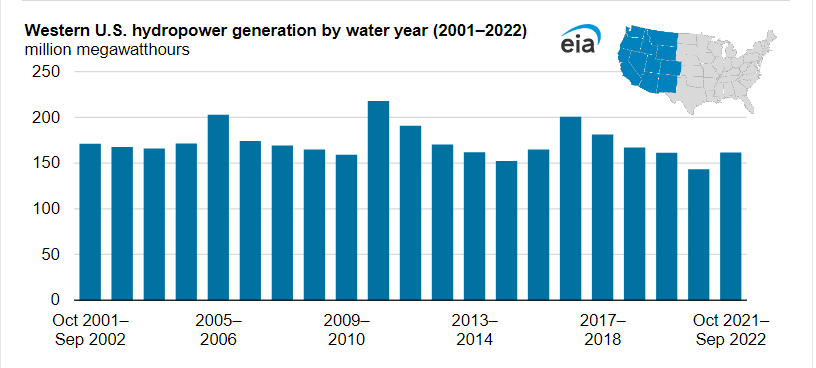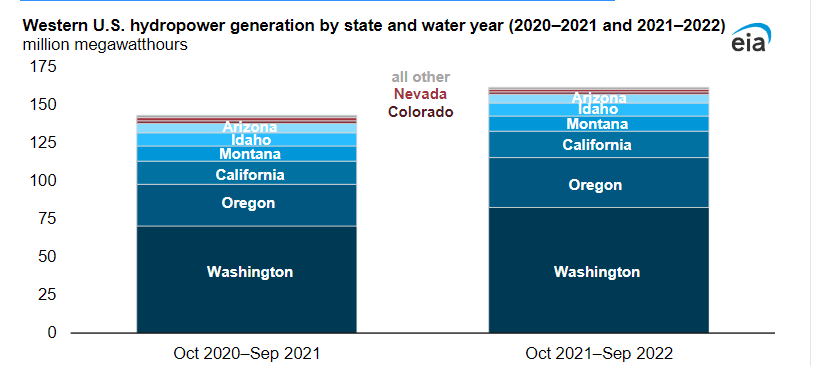After dropping to a 20-year low, western U.S. hydropower generation rose 13% last year

After decreasing to a 20-year low for the 2020–21 water year, hydropower production in the western United States increased slightly during last year’s water year, rising 13% to reach 161 million megawatthours (MWh). Western hydro generation can vary significantly from year to year because it follows rain and snowpack patterns.
A water year covers the 12-month period from October 1 through September 30. The water year follows the water cycle; precipitation in the fall or early winter does not affect stream and river flows until the following spring and summer.
The western United States—Arizona, Colorado, Idaho, Montana, Nevada, New Mexico, Utah, Wyoming, California, Oregon, and Washington—produced 61% of the country’s hydroelectricity last water year (2021–22).
Increases in hydropower generation in the region’s three largest hydropower-producing states—Washington, Oregon, and California—drove last year’s rise in western hydroelectric generation. Combined, these states made up 82% of western hydropower generation in the 2021–22 water year.
Data from the Northwest River Forecast Center and the California Department of Water Resources show that increased precipitation in the 2021–22 water year fueled the increased hydropower generation in these states. Washington’s Grand Coulee Dam, the largest hydropower plant in the country, generated 21.5 million MWh of electricity during the 2021–22 water year, 19% more than it did in the previous water year.

Although hydropower generation in some western states, including Montana, Idaho, and Colorado, was relatively unchanged, well-below-normal flow rates in the Lower Colorado River reduced hydropower generation in Arizona and Nevada. The Hoover Dam, located on the Arizona-Nevada border, is the largest hydropower plant in the Lower Colorado River Basin. It has 17 main turbines; 9 turbines on the Arizona side and 8 turbines on the Nevada side. In the 2021–22 water year, the Hoover Dam generated 10% less electricity than it did in the previous water year because the water level of the dam’s reservoir continued to decline during a historic drought.
From December 2022 to January 2023, a series of atmospheric rivers drenched parts of the western United States, especially California, with large amounts of rain and snow. The snowfall helped establish significant snowpack at high elevations and somewhat replenished reservoirs after years of drought. Although it’s too early to tell, the excessive rainfall in California may have improved the prospects for hydropower production in the state this summer.
We forecast hydropower generation for electricity market regions, rather than at the state level, in our Short-Term Energy Outlook (STEO). In our latest STEO, we forecast that total hydropower production in the western market region (California, Southwest, plus Northwest and Rockies) in the 2022–23 water year will decline slightly, by 4%, from the last water year.
You can return to the main Market News page, or press the Back button on your browser.

